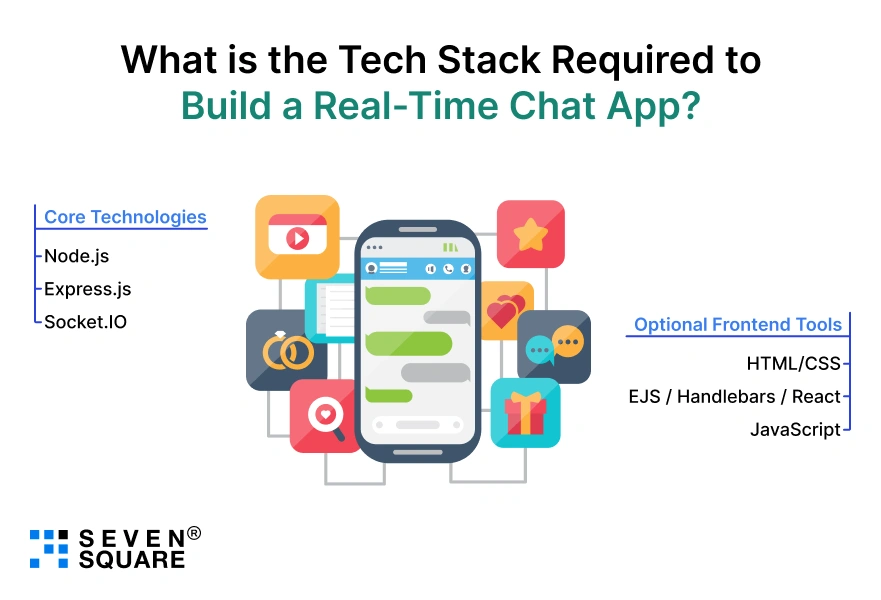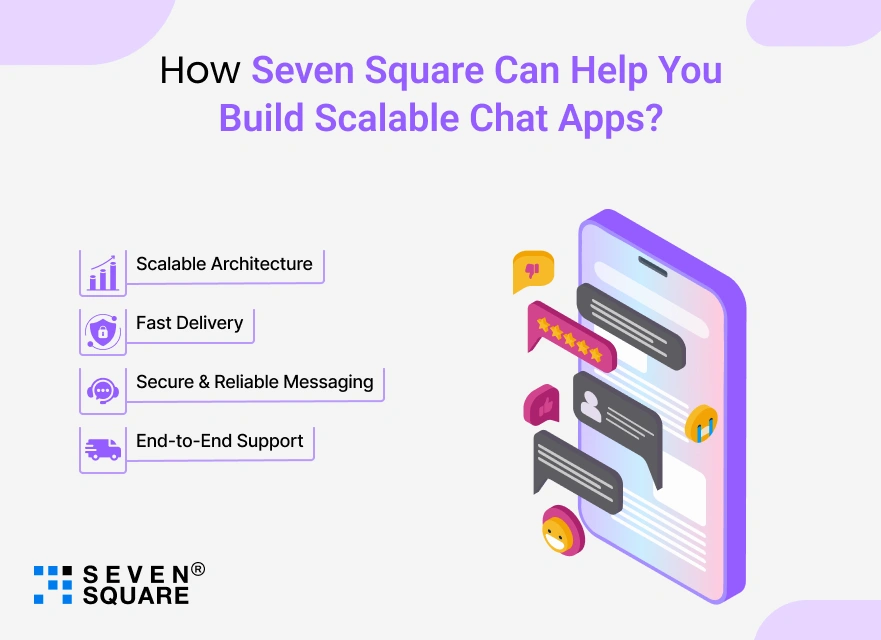Users expect instant communication, whether they’re chatting with friends, messaging customer support, or collaborating in real time.
A few seconds of delay? That’s enough to lose user interest.
That’s where real-time chat apps come in.
These apps keep users engaged by delivering messages instantly and reliably.
If you’re looking to build chat app with socket.io, this blog is for you.
Thanks to Socket.IO, building a real-time chat app is no longer rocket science.
It is a powerful JavaScript library that simplifies the process of creating real-time messaging apps using WebSockets, all with just a few lines of code.
And yes, we’ve got you covered with a complete Socket.IO chat tutorial to help you build chat app with socket.io from scratch.
Here you can get all the details to build real-time chat app Node.Js as you want.
What is Socket.IO and Why Use It for Chat Apps?
If you’re new to real-time mobile app development, Socket.IO is a game changer.
Before we explore the real-time chat app tutorial you need to learn about Socket.IO.
What is Socket.IO?
Socket.IO is a JavaScript library that enables real-time, bidirectional, event-based communication between web clients and servers.
It sits on top of WebSockets, but with added reliability and fallback options, so your users stay connected, even with unstable networks.
Think of it as the engine behind real-time apps like chat platforms, live updates, multiplayer games, and even collaborative tools like Google Docs.
Why Use Socket.IO for Chat Apps?
- Real-time communication without page reloads
- Built-in support for broadcasting messages to all clients
- Works across different browsers and platforms
- Easy integration with Node.js and Express.js
- Supports features like rooms, namespaces, and authentication
Whether you’re building a simple chat room or a full-featured real-time messaging app, Socket.IO gives you the speed, power, and flexibility to do it right.
If you’re looking for a Socket.IO tutorial to get started fast, this blog walks you through every step with working code.
What is the Tech Stack Required to Build a Real-Time Chat App?

To build a production-ready Node.js chat app with Socket.IO, here’s what you’ll need:
Core Technologies:
- Node.js: The JavaScript runtime to power your backend.
- Express.js: A minimal and flexible Node.js framework to handle server routes.
- Socket.IO: For real-time bidirectional messaging over WebSockets.
Together, these tools make the ideal stack for a chat app with Socket.IO and Express.
Optional Frontend Tools:
- HTML/CSS: For basic structure and styling
- EJS / Handlebars / React: For rendering dynamic UI components
- JavaScript: To handle frontend events and real-time socket connections
This tech stack is lightweight, scalable, and beginner-friendly, perfect for anyone who wants to launch fast with high-impact features.
Want to see it in action? Keep reading for a full Node.js chat app tutorial, including the GitHub link so you can clone and customize it right away.
A Step-by-Step Guide to Build a Chat App Using Socket.io
Let’s now create a real-time chat app using Node.js and Socket.IO from scratch.
You can easily have a working Node.js chat application that you can customize or scale.
Step 1: Initialize Your Node.js Project
First, let’s set up the project directory and install dependencies.
mkdir socketio-chat-app
cd socketio-chat-app
npm init -y
npm install express socket.io
Copied!
This initializes your Node.js chat application and installs Express and Socket.IO, which will power our backend and real-time communication.
Step 2: Create the Server with Express and Socket.IO
Create a file called server.js and add the following code:
// server.js
const express = require("express");
const http = require("http");
const { Server } = require("socket.io");
const app = express();
const server = http.createServer(app);
const io = new Server(server);
app.use(express.static("public")); // To serve frontend files
io.on("connection", (socket) => {
console.log("A user connected");
socket.on("chat message", (msg) => {
io.emit("chat message", msg); // Broadcast to all clients
});
socket.on("disconnect", () => {
console.log("User disconnected");
});
});
const PORT = process.env.PORT || 3000;
server.listen(PORT, () => {
console.log(`Server running on http://localhost:${PORT}`);
});
Copied!
This sets up your Socket.IO Node.js backend and prepares it to handle real-time connections.
Step 3: Design the Frontend Chat Interface
Create a folder called public, then inside it, create index.html and script.js.
public/index.html
<!DOCTYPE html>
<html lang="en">
<head>
<meta charset="UTF-8">
<title>Chat App UI</title>
<style>
body { font-family: Arial; margin: 0; padding: 0; }
#chat { padding: 20px; max-width: 600px; margin: auto; }
#messages { list-style: none; padding: 0; }
#messages li { padding: 5px 10px; }
#form { display: flex; }
#input { flex: 1; padding: 10px; }
#send { padding: 10px; }
</style>
</head>
<body>
<div id="chat">
<ul id="messages"></ul>
<form id="form" action="">
<input id="input" autocomplete="off" placeholder="Type your message.." />
<button id="send">Send</button>
</form>
</div>
<script src="/socket.io/socket.io.js"></script>
<script src="script.js"></script>
</body>
</html>
Copied!
public/script.js
const socket = io();
const form = document.getElementById('form');
const input = document.getElementById('input');
const messages = document.getElementById('messages');
form.addEventListener('submit', function(e) {
e.preventDefault();
if (input.value) {
socket.emit('chat message', input.value);
input.value = '';
}
});
socket.on('chat message', function(msg) {
const item = document.createElement('li');
item.textContent = msg;
messages.appendChild(item);
window.scrollTo(0, document.body.scrollHeight);
});
Copied!
This simple Socket.IO chat example shows how to build a real-time frontend that connects with the backend server.
Step 4: Connect Client and Server with WebSockets
At this stage, your client-side JavaScript ( script.js ) is already using Socket.IO to connect to the server. Here’s what’s happening:
- const socket = io(); establishes a WebSocket connection with the backend.
- It listens for incoming messages and displays them in real-time.
- When a user submits a message, it’s sent to the server using socket.emit.
This is the core of any real-time chat app in Node.js, instant & two-way communication between the browser and the server.
Step 5: Add Broadcast Messaging and Join Notifications
Let’s improve the UX with basic join/leave notifications.
Update server.js:
io.on("connection", (socket) => {
console.log("A user connected");
socket.broadcast.emit("chat message", "A new user has joined the chat");
socket.on("chat message", (msg) => {
io.emit("chat message", msg);
});
socket.on("disconnect", () => {
io.emit("chat message", "A user has left the chat");
});
});
Copied!
Now, when someone joins or leaves, the message gets broadcasted to everyone, exactly what users expect from modern real-time chat functionality.
Step 6: Run Your App
node server.js
Copied!
Visit http://localhost:3000 in your browser.
Open multiple tabs to simulate different users in your real-time chat app.
Explore the detailed GitHub code to build chat app with Socker.IO.
What Are the Common Use Cases for Socket.IO Chat Apps?
Socket.IO is not just for basic chat rooms, it powers real-time features in many industries.
Building your first messaging tool, or a business looking to add live communication, here are some powerful real-time messaging app use cases that show where Socket.IO truly shines:
- Customer Support Tools: Offer instant help to users with real-time chat widgets. Live chat plugins on websites, in-app support, or chatbot-human handovers.
- Real-Time Collaboration Apps: Enable multiple users to work together smoothly. It is great for whiteboards, team chats, code editors, and project management tools.
- In-Game Messaging & Multiplayer Features: Power voice or text chat for players in real-time. It can be used in multiplayer games, leaderboards, matchmaking, and game lobbies.
- E-commerce Live Chat: Help shoppers in real time, boost conversions, and reduce shopify cart abandonment rates. Combine Socket.IO with analytics to personalize support.
- Social Networking Apps: Build scalable messaging systems like group chats or DMs. Add features like typing indicators, seen/delivered ticks, and real-time updates.
If you’re planning to build any of the above, Socket.IO gives you the real-time power you need fast, reliable, and scalable.
How Seven Square Can Help You Build Scalable Chat Apps?

Looking to build a real-time chat app that scales with your users?
We help developers, startups, and enterprises turn ideas into powerful messaging platforms with Socket.IO and modern tech stacks.
- Scalable Architecture: Designed to handle growing user traffic and message volumes.
- Fast Delivery: Rapid development cycles so you launch your chat app on time.
- Secure & Reliable Messaging: End-to-end encrypted systems with fallback support and real-time reliability.
- End-to-End Support: From architecture to deployment and beyond.
Whether you’re building a customer support tool, gaming chat app, or real-time collaboration platform, we can help you do it better and faster.
Ready to build your Socket.IO chat app? Contact Us Now!
FAQs
- Socket.IO is used to create real-time, bidirectional communication between clients and servers.
- In chat apps, it enables instant message delivery, live user notifications, and dynamic updates without refreshing the page to make it ideal for real-time messaging apps.
- Yes. WebSocket is more efficient for chat apps because it allows persistent, two-way communication.
- Unlike HTTP, which creates a new connection for each request, WebSocket (used by Socket.IO) keeps the connection open, ideal for real-time chat apps.
- Yes. The frontend of your Socket.IO chat app is fully customizable.
- You can use plain HTML/CSS or integrate frameworks like React, Vue, or Angular to build a modern chat app UI.
- Socket.IO supports secure communication via HTTPS and custom authentication middleware.
- For added protection in your real-time chat app, implement token-based authentication (e.g., JWT), encrypted messages, and user role controls.